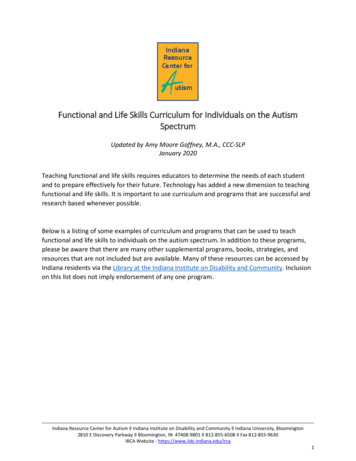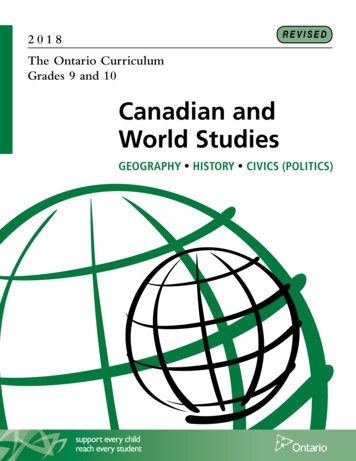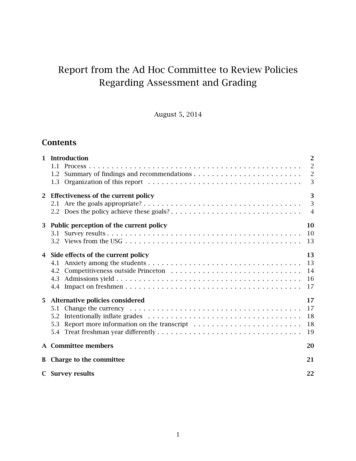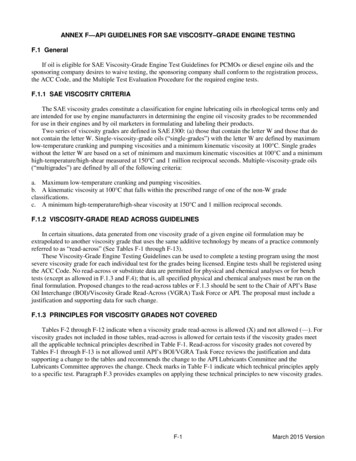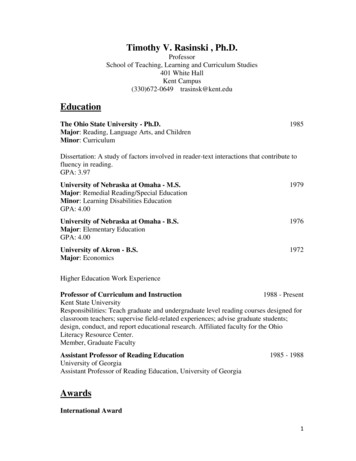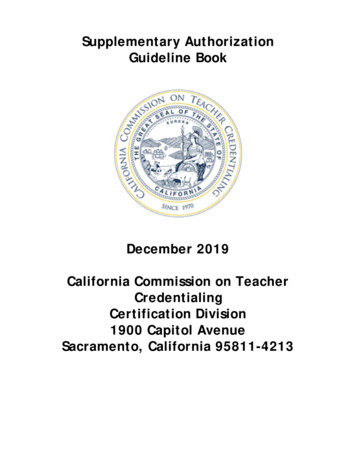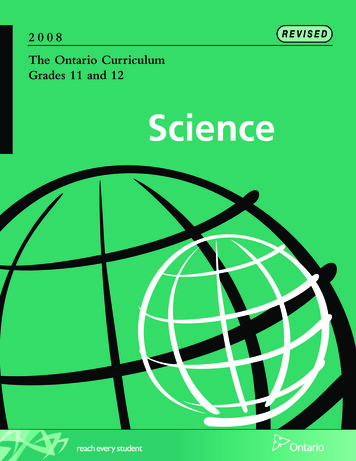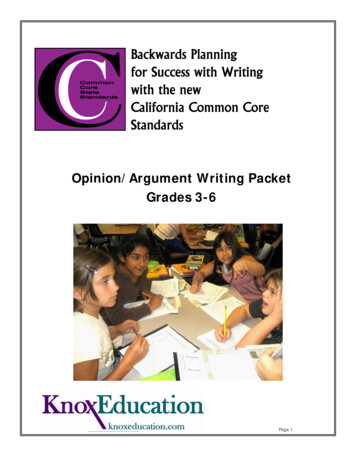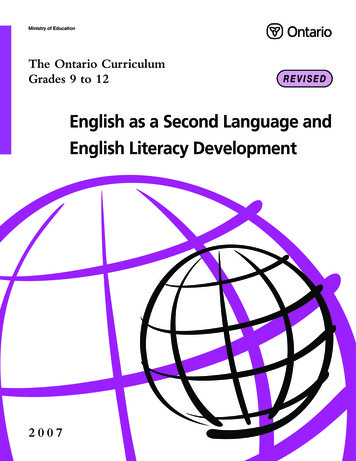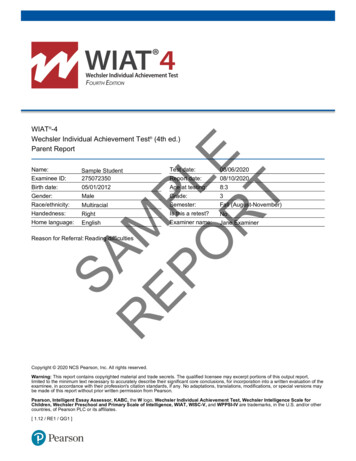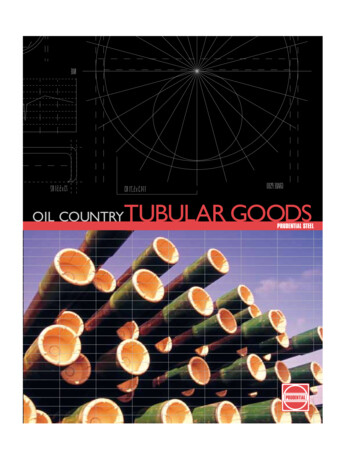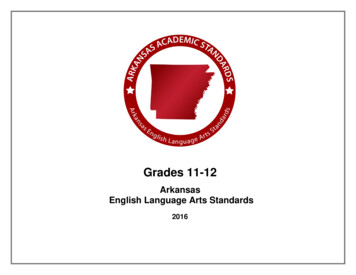
Transcription
Grades 11-12ArkansasEnglish Language Arts Standards2016
Grades 11-12 Table of ContentsIntroduction .3How to Read This Document .4Arkansas Anchor Standards for Reading . . . .7Grades 11-12 Reading Standards for Literature . 8Grades 11-12 Reading Standards for Informational Text . . . .12Arkansas Anchor Standards for Writing . 16Grades 11-12 Writing Standards . . .17Arkansas Anchor Standards for Speaking and Listening 23Grades 11-12 Speaking and Listening Standards . . .24Arkansas Anchor Standards for Language .29Grades 11-12 Language Standards . . . 30Glossary . .36Contributors .382Grades 11-12 ELAArkansas English Language Arts StandardsArkansas Department of Education2016
IntroductionThe Arkansas English Language Arts Standards for Grades K-12 have been developed to prepare students for success after highschool. Students who are successful in college and careers have attained particular literacy capacities. These students demonstrate independence; build strong content knowledge; respond to the varying demands of audience, task, purpose, and discipline; comprehend as well as critique; value evidence; use technology and digital media strategically and capably; come to understand other perspectives and cultures.The English classroom focuses on reading and analyzing literature and literary nonfiction, studying the English language, and writingabout related topics. A separate document, the Arkansas Disciplinary Literacy Standards, has been created to address the uniqueliteracy needs in other content areas.This document is organized around anchor standards and grade-level standards. The anchor standards address overarchingknowledge and skills in reading, writing, speaking and listening, and language. Although the document is organized by strands, thestandards should be integrated during instruction. The grade-level standards, which are aligned to the anchor standards, representthe progression of learning for Grades K-12. The grade-level standards include teacher notes that provide explanations, definitions,and links to resources to support teachers.The document focuses on literacy skills rather than literary content. Teachers have the opportunity to select grade-appropriateliterature and literary nonfiction texts to teach the standards. The texts must provide opportunities to teach all the strands at gradelevel rigor. Three measures of text complexity should guide text selection: quantitative, qualitative, and reader and task. Teachernotes in the grade-level documents provide support for effective text selection.Teachers are encouraged to become familiar with the standards above and below the grade level they teach. The standards belowgrade level will guide decisions for providing interventions for students who do not have all the grade-level skills in place, and thestandards above grade level will guide decisions for extending students who are ready to move ahead. In addition, familiarity with theK-12 standards will support developing a smooth learning progression from kindergarten through high school.The Arkansas Department of Education academic standards are intended to assist in district curriculum development, unit design,and to provide a uniform, comprehensive guide for instruction. The standards are not intended to be a state-mandated curriculum.3Grades 11-12 ELAArkansas English Language Arts StandardsArkansas Department of Education2016
4Grades 11-12 ELAArkansas English Language Arts StandardsArkansas Department of Education2016
5Grades 11-12 ELAArkansas English Language Arts StandardsArkansas Department of Education2016
6Grades 11-12 ELAArkansas English Language Arts StandardsArkansas Department of Education2016
Arkansas Anchor Standards for ReadingThe standards on the following pages define what students should understand and be able to do by the end of the grade orgrade span. The grade-specific standards correspond by number to the Arkansas Anchor Standards for Reading. The ArkansasAnchor Standards and grade-specific standards are necessary complements--the former providing broad standards, the latterproviding additional specificity--that together define the skills and understandings that all students must demonstrate.Key Ideas and Details1. Read closely to determine what the text says explicitly and to make logical inferences from it; cite specific textual evidencewhen writing or speaking to support conclusions drawn from the text.2. Determine central ideas or themes of a text and analyze their development; summarize the key supporting details andideas.3. Analyze how and why individuals, events, and ideas develop and interact over the course of a text.Craft and Structure4. Interpret words and phrases as they are used in a text, including determining technical, connotative, and figurativemeaning; analyze how specific word choices shape meaning and/or tone.5. Analyze the structure of texts, including how specific sentences, paragraphs, and larger portions of the text (e.g., a section,chapter, scene, stanza) relate to each other and the whole.6. Assess how point of view, perspective, and/or purpose shapes the content and style of a text.Integration of Knowledge and Ideas7. Integrate and evaluate content presented in diverse media and formats.8. Analyze and evaluate the argument and specific claims in a text, including the validity of the reasoning as well as therelevance and sufficiency of the evidence9. Analyze how two or more texts address similar themes or topics in order to build knowledge or to compare the approachesof the author(s).Range of Reading and Level of Text Complexity10. Read and comprehend complex literary and informational texts independently and proficiently.Note on Range and Content of Student Reading Grades 6-12To become college and career ready, students must grapple with works of exceptional craft and thought whose range extendsacross genres, cultures, and centuries. Such works offer profound insights into the human condition and serve as models forstudents’ own thinking and writing. Along with high-quality contemporary works, these texts should be chosen from amongseminal U.S. documents, the classics of American literature, and the timeless dramas of Shakespeare. Through wide and deepreading of literature and literary nonfiction of steadily increasing sophistication, students gain a reservoir of literary and culturalknowledge, references, and images; the ability to evaluate intricate arguments; and the capacity to surmount the challengesposed by complex texts.7Grades 11-12 ELAArkansas English Language Arts StandardsArkansas Department of Education2016
Grades 11-12 Reading Standards for LiteratureThe grade-level standards offer a focus for instruction each year and help ensure that students gain adequate exposure to a rangeof texts and tasks. Rigor is also infused through the requirement that students read increasingly complex texts through the grades.Students advancing through the grades are expected to meet each year’s grade-specific standards and retain or further developskills and understandings mastered in preceding grades.Key Ideas and DetailsRL.11-12.1Cite strong and thorough textual evidence to support analysis of what the text says explicitly as well as inferencesdrawn from the text, including determining where the text leaves matters uncertain.RL.11-12.2Examine a grade-appropriate literary text. Provide an objective summary. Determine two or more themes or central ideas of a text and analyze their development over the course ofthe text, including how they interact and build on one another to produce a complex account.Teacher NoteRL.11-12.2Grade-appropriate refers to texts, materials, resources, and activities that are rigorous enough to engage students in grade-levelcontent and concepts across all strands.Grade-appropriate is tied to text complexity. A wide selection of words will be found in texts that align to the three text complexitymeasures: quantitative, qualitative, and reader and task for the Grades 11-12 text complexity band. The texts should also beselected to include words for appropriate word study, and spelling development and should have content and literary merit. Thetext must be rigorous enough to engage students in Grades 11-12 concepts across all four strands of the English Language Artsstandards. Text selection should be a priority consideration when developing a rigorous grade-appropriate curriculum.Theme is a main idea or an underlying meaning of a literary work that may be stated directly or indirectly.An objective summary is a shortened version of an original text that is unbiased and based on facts and does not include personalfeelings, interpretations, or prejudice.RL.11-12.3Analyze how characterization, plot, setting, and other elements interact and contribute to the development andcomplexity of a text.8Grades 11-12 ELAArkansas English Language Arts StandardsArkansas Department of Education2016
Craft and StructureRL.11-12.4Determine the meaning of words and phrases as they are used in the text, including figurative and connotativemeanings; analyze the impact of specific word choices on meaning and tone, including words with multiplemeanings or language that is particularly fresh, engaging, or beautiful.Teacher NoteRL.11-12.4Tone is the author’s attitude towards the subject, characters or situation (e.g., amused, sad, angry).RL.11-12.5Analyze how an author's choices concerning how to structure specific parts of a text (e.g., the choice of where tobegin or end a story, the choice to provide a comedic or tragic resolution) contribute to its overall structure andmeaning as well as its aesthetic impact.RL.11-12.6Analyze a case in which grasping perspective and/or purpose requires distinguishing what is directly stated in atext from what is really meant (e.g., satire, sarcasm, irony, or understatement).Teacher NoteRL.11-12.6It is important to clarify the terms “perspective” and “point of view” for students.Perspective is a particular way of viewing things that depends on one’s experience and personality. (“perspective.” CambridgeAcademic Dictionary. Cambridge UP, 2016, /perspective. Accessed 30 Aug.2016.)Point of view is the position of the narrator in relation to the story (e.g., first person, third person) which is instrumental inmanipulating the reader’s understanding of the narrative. In a way, the point of view can allow or deny the reader access intodeeper understanding of the story. Two of the most common point of view techniques are the first person, in which the story is toldby the narrator from his or her standpoint and the third person in which the narrator is outside of the story and tells the story byreferring to all characters and places in the third person with third person pronouns and proper nouns.In these standards and in an English class, the term “point of view” is used when referring specifically to first person, third person,omniscient, limited, etc., and perspective is used when referring to a particular way of viewing things that depends on one’sexperience and personality. When analyzing literature, both terms are needed.For further clarification, students need to know that it is common practice for disciplines other than English to use the terms “pointof view” and “perspective” interchangeably to mean what English teachers define as perspective.9Grades 11-12 ELAArkansas English Language Arts StandardsArkansas Department of Education2016
Integration of Knowledge and IdeasRL.11-12.7RL.11-12.8RL.11-12.9Analyze multiple interpretations of a story, drama, or poem (e.g., recorded or live production of a play, recordednovel or poetry), evaluating how each version interprets the source text.RL.11-12.8 is not applicable to literature based on anchor standard R.CCR.8.Analyze and evaluate the argument and specific claims in a text, including the validityof the reasoning as well as the relevance and sufficiency of the evidence.Analyze how two or more influential literary works from the same time period address similar themes or topics.Teacher NoteRL.11-12.9Theme is a main idea or an underlying meaning of a literary work that may be stated directly or indirectly.Range of Reading and Level of Text ComplexityRL.11-12.10By the end of Grade 11, read and comprehend literature, including stories, dramas, and poems, in the Grades 1112 text complexity band proficiently, with scaffolding as needed at the high end of the range. By the end of Grade12, read and comprehend literature, including stories, dramas, and poems, at the high end of the Grades 11-12text complexity band independently and proficiently.Teacher NoteRL.11-12.10It is critical that children are reading on grade-level. “In 2011, sociologist Donald Hernandez reported that children who do not readproficiently by the end of third grade are four times more likely to leave school without a diploma than proficient readers.” (Fiester,Leila. “Early Warning Confirmed.” The Annie E. Casey Foundation, 2013, 013.pdf#page 11. Accessed 30 Aug. 2016.)Grades 11-12 must build on the strong foundation from Grades K-10 for students to read on grade level. Students in Grades 11-12should be reading on a Lexile level between 1185L-1385L. By the end of Grade 11, students should be reading independently inthe lower half of the Lexile range and with scaffolding in the upper half of the Lexile range. By the end of Grade 12, students shouldbe reading independently in the upper half of the Lexile range. Students unable to read independently at the grade-level Lexilerange will need more support to reach the goal of reading independently on grade level. Note that the Lexile ranges overlap,recognizing that students can slip backward in reading achievement while they are not receiving reading support such as duringsummer break.10Grades 11-12 ELAArkansas English Language Arts StandardsArkansas Department of Education2016
RL.11-12.10 (continued)Districts choose instructional materials for reading instruction. Text complexity is described in curricular materials using numbers orletters to indicate a learning progression for reading. It is important that the district compare the text complexity of the chosencurriculum against the grade-level Lexile range to ensure that the texts students are expected to read are on grade level. Tomaintain consistency in rigor and to allow for measuring growth, it will be helpful if a district maintains the same system formeasuring text complexity over time and across the grades for accurate comparability.A detailed explanation of the three dimensions of text complexity may be found at the followinglink: onal Governors Association Center for Best Practices, Council of Chief State School Officers. “Supplemental Information forAppendix A.” Common Core State Standards. National Governors Association Center for Best Practices, Council of Chief StateSchool Officers, 2010, A-New-Research-on-Text-Complexity.pdf. Accessed30 Aug. 2016.)A chart with text complexity quantitative measures by grade band may be found at the following page 4.(National Governors Association Center for Best Practices, Council of Chief State School Officers. “Supplemental Information forAppendix A.” Common Core State Standards. National Governors Association Center for Best Practices, Council of Chief StateSchool Officers, 2010, p. 4, A-New-Research-on-Text-Complexity.pdf.Accessed 30 Aug. 2016.)11Grades 11-12 ELAArkansas English Language Arts StandardsArkansas Department of Education2016
Grades 11-12 Reading Standards for Informational TextThe grade-level standards offer a focus for instruction each year and help ensure that students gain adequate exposure to a rangeof texts and tasks. Rigor is also infused through the requirement that students read increasingly complex texts through the grades.Students advancing through the grades are expected to meet each year’s grade-specific standards and retain or further developskills and understandings mastered in preceding grades.Key Ideas and DetailsRI.11-12.1Cite strong and thorough textual evidence to support analysis of what the text says explicitly as well as inferencesdrawn from the text, including determining where the text leaves matters uncertain.RI.11-12.2Examine a grade-appropriate informational text. Provide an objective summary of the text. Determine two or more central ideas of a text and analyze their development over the course of the text,including how they interact and build on one another to provide a complex analysis.Teacher NoteRI.11-12.2Grade-appropriate refers to texts, materials, resources, and activities that are rigorous enough to engage students in grade-levelcontent and concepts across all strands.Grade-appropriate is tied to text complexity. A wide selection of words will be found in texts that align to the three text complexitymeasures: quantitative, qualitative, and reader and task for the Grades 11-12 text complexity band. The texts should also beselected to include words for appropriate word study, and spelling development and should have content and literary merit. Thetext must be rigorous enough to engage students in Grades 11-12 concepts across all four strands of the English Language Artsstandards. Text selection should be a priority consideration when developing a rigorous grade-appropriate curriculum.An objective summary is a shortened version of an original text that is unbiased and based on facts and does not include personalfeelings, interpretations, or prejudice.RI.11-12.3Analyze a complex set of ideas or sequence of events and explain how specific individuals, ideas, or eventsinteract and develop over the course of the text.12Grades 11-12 ELAArkansas English Language Arts StandardsArkansas Department of Education2016
Craft and StructureRI.11-12.4Determine the meaning of words and phrases as they are used in a text, including figurative, connotative, andtechnical meanings; analyze how an author uses and refines the meaning of a key term or terms over the courseof a text, including words with multiple meanings or language that is particularly fresh, engaging, or beautiful.RI.11-12.5Analyze and evaluate the effectiveness of the structure an author uses, including whether the structure makespoints clear, convincing, and engaging.RI.11-12.6Determine an author's point of view, perspective, or purpose in a text in which the rhetoric is particularly effective,analyzing how style and content contribute to the power, persuasiveness, or beauty of the text.Teacher NoteRI.11-12.6It is important to clarify the terms “point of view” and “perspective” for students.Point of view is the position of the narrator in relation to the story (e.g., first person, third person) which is instrumental inmanipulating the reader’s understanding of the narrative. In a way, the point of view can allow or deny the reader access intodeeper understanding of the story. Two of the most common point of view techniques are the first person, in which the story is toldby the narrator from his or her standpoint and the third person in which the narrator is outside of the story and tells the story byreferring to all characters and places in the third person with third person pronouns and proper nouns.Perspective is a particular way of viewing things that depends on one’s experience and personality. (“perspective.” CambridgeAcademic Dictionary. Cambridge UP, 2016, /perspective. Accessed 30 Aug.2016.)In these standards and in an English class, the term “point of view” is used when referring specifically to first person, third person,omniscient, limited, etc., and perspective is used when referring to a particular way of viewing things that depends on one’sexperience and personality. When analyzing literature, both terms are needed.For further clarification, students need to know that it is common practice for disciplines other than English to use the terms “pointof view” and “perspective” interchangeably to mean what English teachers define as perspective.13Grades 11-12 ELAArkansas English Language Arts StandardsArkansas Department of Education2016
Integration of Knowledge and IdeasRI.11-12.7Integrate and evaluate multiple sources of information presented in diverse media or formats in order to address aquestion or solve a problem.RI.11-12.8Delineate and evaluate the reasoning, premises, purposes, and arguments in texts such as works of publicadvocacy or foundational documents.RI.11-12.9Analyze documents of historical and literary significance, including U.S. documents when appropriate, for theirthemes, purposes, and rhetorical features.Teacher NoteRI.11-12.9Theme is a main idea or an underlying meaning of a literary work that may be stated directly or indirectly.Range of Reading and Level of Text ComplexityRI.11-12.10By the end of Grade 11, read and comprehend literary nonfiction in the Grades 11-12 text complexity bandproficiently, with scaffolding as needed at the high end of the range. By the end of Grade 12, read andcomprehend literary nonfiction at the high end of the Grades 11-12 text complexity band independently andproficiently.Teacher NoteRI.11-12.10It is critical that children are reading on grade-level. “In 2011, sociologist Donald Hernandez reported that children who do not readproficiently by the end of third grade are four times more likely to leave school without a diploma than proficient readers.” (Fiester,Leila. “Early Warning Confirmed.” The Annie E. Casey Foundation, 2013, 013.pdf#page 11. Accessed 30 Aug. 2016.)Grades 11-12 must build on the strong foundation from Grades K-10 for students to read on grade level. Students in Grades 11-12should be reading on a Lexile level between 1185L-1385L. By the end of Grade 11, students should be reading independently inthe lower half of the Lexile range and with scaffolding in the upper half of the Lexile range. By the end of Grade 12, students shouldbe reading independently in the upper half of the Lexile range. Students unable to read independently at the grade-level Lexilerange will need more support to reach the goal of reading independently on grade level. Note that the Lexile ranges overlap,recognizing that students can slip backward in reading achievement while they are not receiving reading support such as duringsummer break.14Grades 11-12 ELAArkansas English Language Arts StandardsArkansas Department of Education2016
RI.11-12.10 (continued)Districts choose instructional materials for reading instruction. Text complexity is described in curricular materials using numbers orletters to indicate a learning progression for reading. It is important that the district compare the text complexity of the chosencurriculum against the grade-level Lexile range to ensure that the texts students are expected to read are on grade level. Tomaintain consistency in rigor and to allow for measuring growth, it will be helpful if a district maintains the same system formeasuring text complexity over time and across the grades for accurate comparability.A detailed explanation of the three dimensions of text complexity may be found at the following (National Governors Association Center for Best Practices, Council of Chief State School Officers. “Supplemental Information forAppendix A.” Common Core State Standards. National Governors Association Center for Best Practices, Council of Chief StateSchool Officers, 2010, A-New-Research-on-Text-Complexity.pdf. Accessed30 Aug. 2016.)A chart with text complexity quantitative measures by grade band may be found at the following page 4.(National Governors Association Center for Best Practices, Council of Chief State School Officers. “Supplemental Information forAppendix A.” Common Core State Standards. National Governors Association Center for Best Practices, Council of Chief StateSchool Officers, 2010, p. 4, A-New-Research-on-Text-Complexity.pdf.Accessed 30 Aug. 2016.)15Grades 11-12 ELAArkansas English Language Arts StandardsArkansas Department of Education2016
Arkansas Anchor Standards for WritingThe standards on the following pages define what students should understand and be able to do by the end of the grade or gradespan. The grade-specific standards correspond by number to the Arkansas Anchor Standards for Writing. The Arkansas AnchorStandards and grade-specific standards are necessary complements--the former providing broad standards, the latter providingadditional specificity--that together define the skills and understandings that all students must demonstrate.Text Types and Purposes1. Write arguments to support claims when analyzing substantive topics or texts using valid reasoning and relevant, sufficient evidence.2. Write informative/explanatory texts to examine and convey complex ideas and information clearly and accurately through the effectiveselection, organization, and analysis of content.3. Write narratives to develop real or imagined experiences or events using effective technique, well-chosen details and well-structuredevent sequences.Production and Distribution of Writing4. Produce clear and coherent writing in which the development, organization, and style are appropriate to task,purpose, and audience.5. Develop and strengthen writing as needed by planning, revising, editing, rewriting, or trying a new approach.6. Use technology, including the Internet, to produce and publish writing and to interact and collaborate with others.Research to Build and Present Knowledge7. Conduct short as well as more sustained research projects based on focused questions, demonstrating understanding ofthe subject under investigation.8. Gather relevant information from multiple print and digital sources, assess the credibility and accuracy of each source, andintegrate the information while avoiding plagiarism.9. Draw evidence from literary and/or informational texts to support analysis, reflection, research, and synthesis.Range of Writing10. Write routinely over extended time frames (time for research, reflection, and revision) and shorter time frames (a single sitting or a dayor two) for a range of tasks, purposes, and audiences.Note on Range and Content of Student Writing Grades 6-12For students, writing is a key means of asserting and defending claims, showing what they know about a subject, and conveying whatthey have experienced, imagined, thought, and felt. To be college- and career- ready writers, students must take task, purpose, andaudience into careful consideration, choosing words, information, structures, and formats deliberately. They need to know how tocombine elements of different kinds of writing--for example, to use narrative strategies within argument and explanation withinnarrative--to produce complex and nuanced writing. They need to be able to use technology strategically when creating, refining, andcollaborating on writing. They have to become adept at gathering information, evaluating sources, and citing material accurately,reporting findings from their research and analysis of sources in a clear and cogent manner. They must have the flexibility,concentration, and fluency to produce high-quality first-draft text under a tight deadline as well as the capacity to revisit and makeimprovements to a piece of writing over multiple drafts when circumstances encourage or require it.16Grades 11-12 ELAArkansas English Language Arts StandardsArkansas Department of Education2016
Grades 11-12 Writing StandardsThe following standards offer a focus for writing instruction to help ensure that students gain adequate mastery of a range of skillsand applications. Each year in their writing, students should demonstrate increasing sophistication in all aspects of language use,from vocabulary and syntax to the development and organization of ideas, and they should address increasingly demandingcontent and sources. Students advancing through the grades are expected to meet each year’s grade-specific standards andretain or further develop skills and understandings mastered in preceding grades. The expected growth in student writing ability isreflected in the standards.Text Types and PurposesW.11-12.1Write arguments to support claims when analyzing substantive topics or texts, using valid reasoning andrelevant, sufficient evidence.W.11-12.1.AIntroduce precise, knowledgeable claim(s), establish the significance of the claim(s), distinguish the claim(s)from alternate or opposing claims, and create an organization that logically sequences claim(s), counterclaims,reasons, and evidence.W.11-12.1.BDevelop claim(s) and counterclaims fairly and thoroughly, supplying the most relevant evidence and insightfulcomme
knowledge and skills in reading, writing, speaking and listening, and language. Although the document is organized by strands, the . reading of literature and literary nonfiction of steadily increasing sophistication, students gain a reservoir of literary and cultural . Analyze and evaluate the
